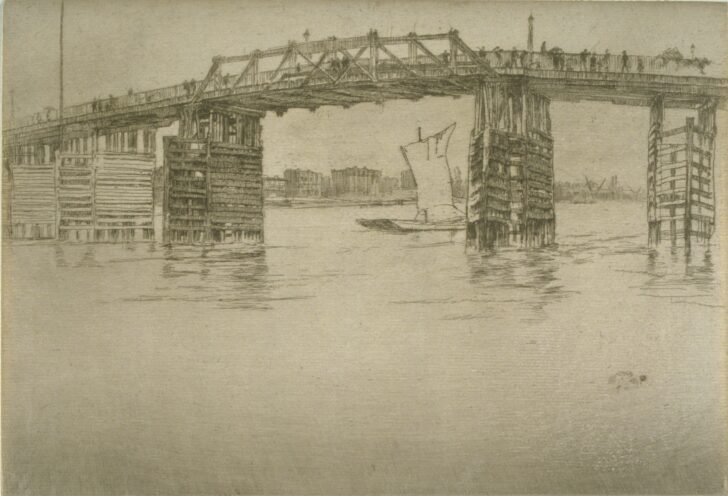Old Battersea Bridge
James Abbott McNeill Whistler

Description
Old Battersea Bridge
1879
Etching and drypoint
Fourth state of five (Kennedy 177)
Bequest of Margaret Watson Parker, 1954/1.371
The lithographs Whistler made in 1878 did not generate the interest he had wished—the buying public seemed to prefer his earlier realist etchings of the Thames Set, which was reissued in 1879, to his new lithographic work—and he returned to etching in the hope that there would be a better response. This etching and drypoint of the old Battersea Bridge is a more conventional depiction than either of the lithographs Whistler executed the previous year, its scale and more finished style harking back to the Thames etchings of 1859. Nevertheless, the low vantage point and the way the bridge frames the view of the distant shore shows how Whistler was incorporating new ideas from Japanese prints, even while returning to his earlier medium and subject matters.
It is likely this was etched before Whistler’s bankruptcy and departure for Venice, but the retention of ink along the bottom edge as a way to indicate shadow on the surface of the water—a printing technique he began to use in Venice in order to create tone in his etchings—indicates that it may have been printed after his return. The rest of the plate was cleanly wiped, lending the image a flatter, floating quality reminiscent of Japanese prints.
Subject Matter:
The Old Battersea Bridge was slated for demolition to begin in 1883 and Whistler returned to the portrayal of the picturesque old timber structure in nearly all media--painting, pastel, lithography, and etching. The low vantage point looking between the piers shows Whistler's affinity for Japanese woodblock prints of similar subjects.
Physical Description:
Seen from the surface of a river, a segment of a wooden bridge carries both carriages and pedestrians across the span. The piers of the bridge are reinforced with horizontal boards to protect against collision. Between the piers the distant shore shows numerous buildings and dry-dock cranes. In the center span, a low boat with a sail is about to pass under the bridge, moving towards the viewer.
Usage Rights:
If you are interested in using an image for a publication, please visit https://umma.umich.edu/request-image/ for more information and to fill out the online Image Rights and Reproductions Request Form.